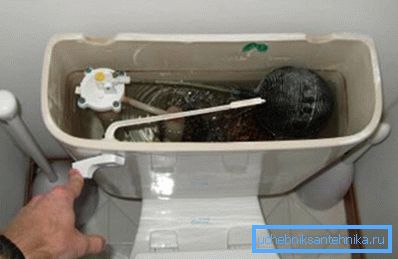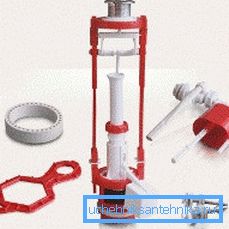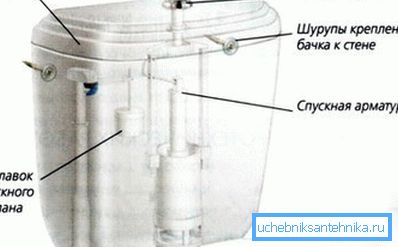Drainage system for toilet: how to choose its most effective
It is impossible to imagine a comfortable stay without modern plumbing devices. We visit the toilet every day, and the failure of any part makes us very nervous. Most often, the drain tank brings, because there are a lot of elements in it, each of which is important in its own way.

Device classification
Today there is an opportunity to choose a tank model that suits you in all respects. A modern toilet flush system is selected for both the interior features and the taste of the owner. The long-thought-out principle of operation remained the same, but there appeared a mass of modifications.
Location of fixture

- Tank, combined with the toilet. In the aggregate, a convenient and compact unified system is obtained. The design is mounted immediately, there is no need to install a transition pipe between the toilet and water storage.
- Suspended type. Similar to the very first toilets. Retro fashion has given a touch of elegance to the ordinary "pull the rope," now the systems look very aesthetically pleasing. High-quality flush due to the powerful pressure spoils the small minus - the toilet hanging system for the toilet is noisy louder than other models.
- Hidden (embedded) systems. Outside, there is only a bowl for use, the drain system is mounted in the wall.
Note! The design is ideal for a small toilet, as well as a minimalist style. Simply press the button located on the panel, and the water will wash away all unnecessary.
Trigger Type

And here everything is done for the convenience of the user or under the overall style. Ultramodern copies open water automatically, guided by the program pledged.
But these are more often exclusive items, made mostly for order.
- The most popular button system toilet cistern. The button is placed on the side or in the center of the drain bowl, in closed types of appliances. It is considered one of the most reliable and convenient.
- Exhaust version. A bit outdated analog, but well-proven. Water flows after lifting up the stem, which opens a hole inside the tank.

- Lever system. The descent is made by pressing the lever or pulling the chain. Additions are located on the side and most often on suspension models.
Material
To date, there are three most popular varieties - appliances made of ceramics, plastic and cast iron.
- The most frequently used faience elements, successfully functioning both in the suspended and in the combined version.
- The plastic drainage system in the toilet is optimal for structures built into the wall. As a rule, they have a non-standard form and more compact dimensions.
- Cast iron was used in old models, served for a long time, but the replacement of parts cost a lot of effort. It is still possible to find cast-iron tanks, which have been in continuous operation for more than a dozen years.
What is the tank

Without knowing what the toilet cistern system consists of, it is impossible to identify the cause of the breakdown and, moreover, to eliminate it.
- Float. It regulates the water level in the tank. When filled to the desired level, the float floats, blocking the access of fluid to the tank.
- Lever-mounted ball valve. It provides water to the tank.
- Rubber, plastic pear. Blocks drain hole, not allowing water to leak. When you press the lever, the hole opens, releasing the flow from the drive.
- Overflow mechanism. This system of filling the toilet bowl does not allow water to overflow. The simplest design is a hole at the back or side of the bowl, connected to a common sewer. In case of overflow, excess fluid simply goes into the common sewer riser.
Filling Methods

You can find three types of filling the tank.
- Water is supplied from below. The principle is almost completely silent.
- The liquid flows from above. Requires installation of additional devices to ensure quiet operation.
- Feed is provided on the side. In this case, the owners often complain about the noise every time they are flushed.
Note! You can get rid of the noise with your own hands. Open the tank and connect a piece of rubber hose to the supply valve. The other end should reach the bottom of the bowl. Now the water will quietly flow immediately to the bottom.
Frequent problems and their elimination
- Water constantly leaks and runs like a stream down the toilet. The reason for this is a deformed or broken pear. Remove the lid and check the operation of the toilet flush valve. If the pear has shifted, it is enough to adjust it manually. A torn or heavily skewed element will have to be replaced with a new one.
- A constant flow of water into the reservoir and its excess flow into the sewer. Here you should pay attention to the inspection of the float. Perhaps it is depressurized, and water got inside. You can try to seal the hole, but it is better to replace the valve, as the price of the components is low and they are not in short supply in stores.
Operation Tips

It is clear that sanitary fixtures must be protected. Rough attitude to modern, mostly capricious devices, leads to rapid breakdowns.
Consequently, the instruction to the toilet flush system is reduced to proper handling and compliance.
- Do not press the button or drain lever with undue force. If, after smooth action, the tank does not wash out, it means that a breakdown has occurred.
- To change the water level in the bowl (lower it) it is enough to ensure a high float position. The easiest way to do this, securing a piece of foam under it.
- When you intend to replace the part with a new one, be sure to take the broken one to the store with you. Then the seller will give you exactly what you need. It is sometimes very difficult or impossible to fit non-standard or unsuitable valves.
Conclusion
Choose a tank, being guided not only its external data. Material, design features and manufacturer's reputation matter. Examine a simple device, and then you can troubleshoot for free on your own.
Pay attention to the video in this article, there you will find answers to your questions.